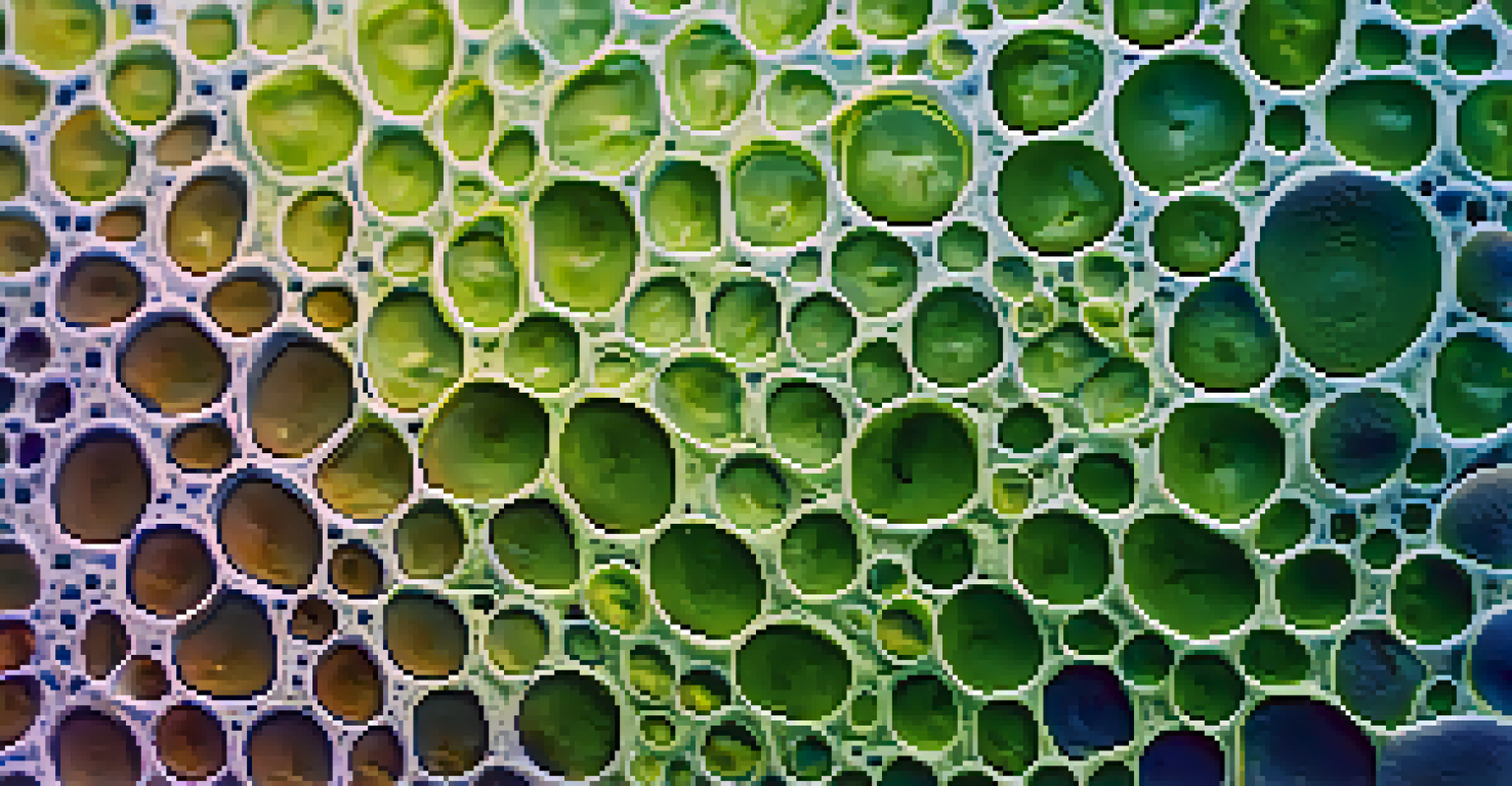Carbon Sequestration: The Role of Algae in Climate Solutions

Understanding Carbon Sequestration and Its Importance
Carbon sequestration is the process of capturing and storing carbon dioxide (CO2) from the atmosphere. This is crucial for combating climate change, as excess CO2 contributes to global warming. By reducing the amount of carbon in the atmosphere, we can mitigate the effects of climate change and promote a healthier planet.
The greatest threat to our planet is the belief that someone else will save it.
Various methods of carbon sequestration exist, including geological and biological approaches. The biological methods harness natural processes, such as photosynthesis, to absorb CO2. This is where algae comes into play, offering a unique and powerful solution to this pressing issue.
Algae are some of the most efficient organisms at capturing carbon dioxide. They can absorb CO2 at a much higher rate than terrestrial plants due to their rapid growth and vast surface area. This makes them a promising ally in our fight against climate change.
The Science Behind Algae's Carbon Capture
Algae utilize photosynthesis to convert sunlight, CO2, and water into energy, releasing oxygen as a byproduct. This natural process is similar to how land plants operate; however, algae can achieve this in aquatic environments. The efficiency of algae in photosynthesis makes them a powerhouse for carbon capture.

Different species of algae, such as microalgae and macroalgae, have varying capabilities for carbon sequestration. Microalgae, for instance, can grow incredibly fast, doubling their biomass in just a few hours. This rapid growth means they can absorb CO2 quickly and effectively, making them a key player in carbon capture strategies.
Algae's Role in Carbon Sequestration
Algae are highly efficient at capturing carbon dioxide, making them vital allies in our fight against climate change.
Furthermore, when algae die, they can sink to the ocean floor, effectively trapping carbon in the deep sea for long periods. This process, called 'biological carbon pump,' helps to sequester carbon away from the atmosphere, demonstrating the critical role algae play in long-term climate solutions.
Algae in Agriculture: A Sustainable Approach
Incorporating algae into agricultural practices can enhance carbon sequestration while also providing additional benefits. For example, algae can be used as a natural fertilizer, enriching soil health and improving crop yields. This dual-purpose approach not only sequesters carbon but also supports food security.
We won't have a society if we destroy the environment.
Farmers can cultivate algae in ponds or integrate it into existing farming systems, creating a sustainable cycle. By utilizing waste products from agriculture, such as manure, to feed algae, we can close the loop on nutrient cycles. This reduces waste and promotes a more sustainable agricultural system.
Moreover, the integration of algae into farming practices can help sequester carbon in the soil. Healthy soils, enriched with organic matter from algae, can store more carbon, further contributing to climate change mitigation efforts. This multifaceted approach showcases the versatility of algae in our climate solutions toolkit.
Innovative Technologies Utilizing Algae
Several innovative technologies are emerging that harness the power of algae for carbon sequestration. Algal biofuels, for instance, are a renewable energy source that captures CO2 during production. This not only provides an alternative to fossil fuels but also contributes to reducing greenhouse gas emissions.
Some companies are investing in algae-based carbon capture systems that can be integrated into industrial processes. These systems capture CO2 emissions directly from factories and utilize algae to convert this waste into valuable products, such as biofuels or animal feed. This closed-loop system not only reduces emissions but also creates new economic opportunities.
Innovative Uses of Algae Technology
Emerging technologies that utilize algae for carbon capture and biofuel production demonstrate the potential for sustainable solutions.
Research is ongoing to optimize these technologies and explore new applications for algae. From bioplastics to pharmaceuticals, the potential uses for algae are vast, and integrating them into various industries can significantly enhance our efforts in carbon sequestration.
The Role of Oceanic Algae in Climate Regulation
Oceanic algae, or phytoplankton, play a crucial role in regulating the Earth's climate. These tiny organisms are responsible for producing a significant portion of the world's oxygen and absorbing a substantial amount of CO2. The health of oceanic algae directly impacts global carbon cycles and climate stability.
Unfortunately, factors like pollution, ocean warming, and acidification threaten the health of these vital ecosystems. Protecting oceanic algae is essential not just for carbon sequestration but also for maintaining biodiversity and supporting marine life. Their decline could have cascading effects on the entire ecosystem.
Conserving marine environments and promoting the growth of phytoplankton can enhance their ability to sequester carbon. Efforts to reduce pollution and combat climate change on land will also benefit these oceanic organisms, highlighting the interconnectedness of our environmental efforts.
Challenges and Limitations of Algae in Carbon Sequestration
Despite the promising potential of algae for carbon sequestration, there are challenges to consider. Issues such as land and water use, nutrient availability, and the potential for harmful algal blooms need to be addressed. Sustainable management practices are essential to ensure that algae cultivation does not negatively impact ecosystems.
Another challenge is the scalability of algae technologies. While research has shown great promise, transitioning from small-scale experiments to large-scale implementation requires significant investment and innovation. Overcoming these hurdles will be critical to fully harnessing algae's potential in climate solutions.
Challenges in Algae Cultivation
Despite their promise, challenges such as scalability and environmental impacts must be addressed for effective algae-based carbon sequestration.
Finally, public perception and regulatory frameworks can influence the adoption of algae-based technologies. Educating communities about the benefits of algae and addressing any concerns will be vital for promoting sustainable practices. Collaboration between scientists, policymakers, and the public can pave the way for more effective carbon sequestration strategies.
The Future of Algae in Climate Solutions
Looking ahead, the future of algae in carbon sequestration appears promising. As technology advances, we can expect to see more efficient methods for cultivating and utilizing algae. Innovations in biotechnology and sustainable practices will play a pivotal role in maximizing their potential.
Moreover, as awareness of climate change grows, there is an increasing demand for sustainable solutions. Algae offer a unique opportunity to address multiple environmental challenges, from carbon capture to waste reduction. This potential can drive further investment and research into algae-based solutions.

Engaging communities and fostering collaboration between various stakeholders will be essential for the successful integration of algae into climate strategies. Together, we can unlock the full potential of these remarkable organisms, making a significant impact in the fight against climate change.